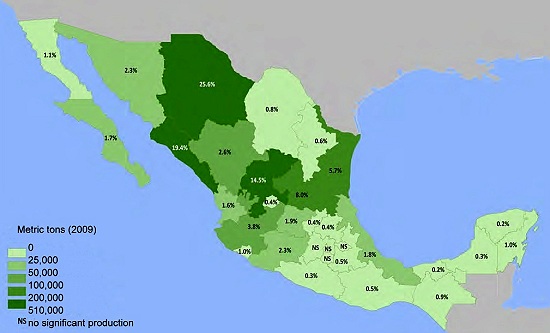In a previous post, we saw how chiles (Capsicum spp.) have been cultivated in Mexico for centuries (the oldest record of domestication dates back to 4100BC) and they made an important contribution to Mexico’s traditional cuisine being recognized by UNESCO as an “Intangible Cultural Heritage of Humanity.”In this post we take a closer look at where they are grown, how many are produced and how valuable the annual crop is for the domestic market and for export.
For an overview of different kinds of chiles, see these two articles by Karen Hursh Graber on MexConnect:
- Warm Reading For Cool Nights: A Guide To Mexican Chiles
- Warm Reading For Cool Nights: A Guide To Mexican Chiles Part 2: Dried Chiles
Area cultivated
The area cultivated for chiles has declined slightly over the last decade from 145,000 hectares to 141,000; about 85% of this area is irrigated. However, the volume of total production has risen by an average of 1.5%/yr, due to the application of improved techniques, knowledge and equipment, especially the increased use of greenhouses. Each year, a small percentage of the cultivated area is not harvested due to the adverse impacts of diseases, pests and climatic events.
Cultivation location, production volumes and value
Mexico’s total annual chile production is around 2 million tons [cf China’s 14.3 million tons]. By variety, about 30% of production is jalapeño chiles, followed by serrano (10.9%), poblano (9.7%) and morrón (8.1%). These four account for 60% of production:
- jalapeño (619,000 tons in 2009): Chihuahua (42%), Sinaloa (12.9%), Jalisco (6.6%) and Michoacán (6.3%)
- serrano (217,000 tons): Tamaulipas (38.7%) and Sinaloa (30.9%)
- poblano (192,000 tons): spread between 16 states, led by Zacatecas (32.7%), Sinaloa (20.6%) and Guanajuato (13.2%)
- morrón (162,000 tons): Sinaloa (96%)
The map shows total production volume on a state-by-state basis.
In summary, 2 out of every 3 green chiles grown in Mexico come from Chihuahua, Sinaloa, Zacatecas and San Luis Potosí.
Domestic market for chiles
The average consumption in Mexico is about 15 kg/person. For the period 2000-2010, domestic consumption oscillated around 1.5 million tons/yr. As international demand rises, there is a slightly reduced supply of chiles to the domestic market.
Trade in chiles (exports and imports)
International trade in chiles began shortly after Columbus introduced them to Europe as “peppers of the Indies”.
Today, as noted earlier, Mexico is the world’s leading exporter of green chiles, and ranks 6th for dried chiles. About 25% of Mexico’s chile production is exported. Over the last decade (2000-2009), exports have grown at a rate of about 15%/yr in volume, and 13% in value. In 2009, chile exports were worth 720 million dollars. Exports go to 52 countries, though a whopping 98% go to the USA, followed by the UK, Canada, Germany and Japan.
Mexico also imports some chiles each year. From 2000-2009, imports (almost entirely dried chiles) averaged 30,000 tons, at a cost of around 100 million dollars. China is Mexico’s main provider, followed by Peru, the USA and Spain.
Chile tourism
La Feria del Chile (The Chile Fair) in Queréndaro, Michoacán
Recipes with Chiles:
- Preparing Mexico’s classic chiles rellenos: Step by step by Chef Daniel Wheeler
- Stuffed chiles in walnut sauce: Chiles en nogada by Karen Hursh Graber
- Easy Chiles Rellenos by Karen Hursh Graber
Main source (pdf file): Un panorama del cultivo del chile, SAGARPA: Servicio de Información Agroalimentaria y Pesquera, June 2010.
[accessed January 28, 2011]
Agriculture in Mexico is analyzed in chapter 15 of Geo-Mexico: the geography and dynamics of modern Mexico. Ask your library to buy a copy of this handy reference guide to all aspects of Mexico’s geography today! Better yet, order your own copy…

Sorry, the comment form is closed at this time.